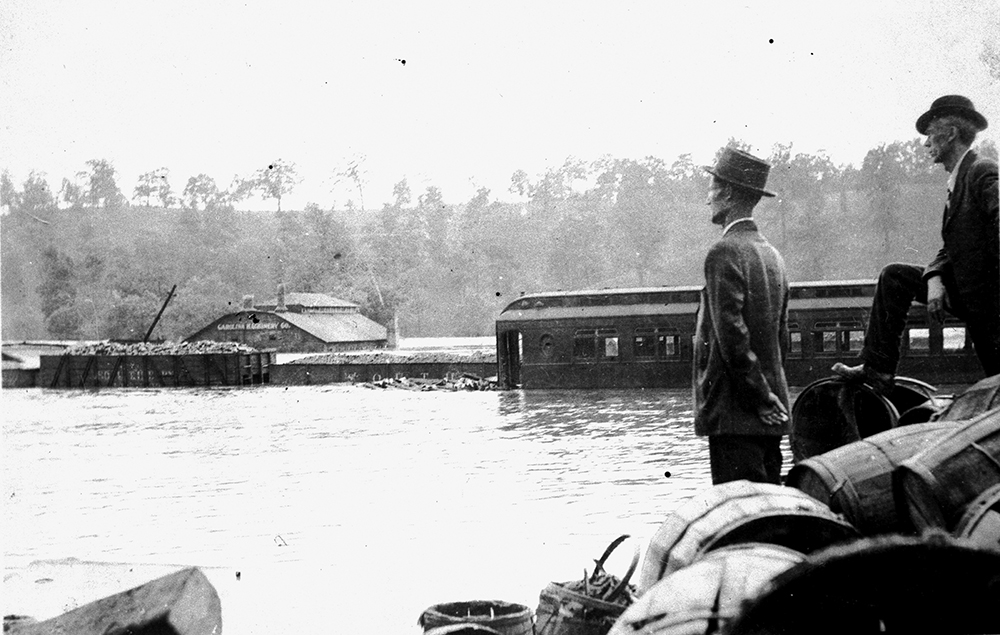
Men standing on a railroad bridge in McDowell County after it had been washed away during the July 1916 flood. Courtesy North Carolina Collection, University of North Carolina, Chapel Hill.
The Great Flood of 1916 was the worst natural disaster in Western North Carolina’s history. The rain began to fall the first week in July and continued through mid-month. At one point, 22 inches was recorded in just a 24-hour period. The French Broad River crested 17 feet above flood stage, every dam burst, and the entire city of Hendersonville was isolated in a sea of water, causing an estimated $22 million in damage to the region (that’s nearly half-a-billion dollars by today’s count).
Now, while there’s still an opportunity, the Hendersonville-based Center for Cultural Preservation wants to glean valuable lessons from those who recall the impact of that event. The small, volunteer-run nonprofit has completed more than 50 oral histories with “mountain elders” across 10 WNC counties. “There isn’t anyone alive today who was around then,” clarifies the center’s executive director, David Weintraub. “The interviews are with people whose family, friends, and community were impacted by the flood. I just interviewed a 99-year-old woman who was born two weeks after the flood. Even though she wasn’t there when the flood occurred, it was an important family story growing up.
Two young girls in her family were washed away miles downstream, their mother was found hanging on a tree … it’s pretty incredible stuff.”
On December 3rd, the organization will convene a forum, “Come Hell or High Water — Remembering the 1916 Flood,” at Blue Ridge Community College. In addition to the oral histories, the gathering will feature a slideshow and talks by flood-mitigation experts, geologists, and local historians.
“Floods are never one-time events,” says Weintraub. “The memories of the flood of 1916 came back to haunt WNC in 1996” — when Hurricane Fran came roaring into the area — “as well as in 2004,” when Hurricanes Frances and Ivan, only nine days apart, struck the region in September.
“What’s different today,” says Weintraub, “is that the population is nearly 10 times larger, and the sense of community today, compared to the past, is likely ten times smaller.”
He acknowledges that progress has been made to protect mountain communities. But he also argues that “given the sheer number of people living near flood zones, and the resistance by many counties to impose stricter land-use regulations, we might actually be more vulnerable to huge floods or other natural disasters than in 1916.”
The Flood of 1916 began when the confluence of normal seasonal rains was joined by a Category 3 hurricane that dropped heavy precipitation on the area, and was then joined by a Category 2 hurricane that deluged the region starting the week after, triggering hundreds of landslides. Fortunately, fewer homes were built at the top of steep slopes back then. Today, believes Weintraub, homes built on the ridges “would act as huge sleds, demolishing everything below.”
“Today, given our less-connected community, I think rebuilding would be more onerous and more difficult,” says Weintraub. “But I truly believe that as we reclaim the lessons of our elders, that we can become the community again that our elders envisioned — one that can meet any challenge, and one where people feel part of a larger whole, instead of isolated.”
“Come Hell or High Water — Remembering the 1916 Flood” happens Thursday, December 3, 7pm, in Patton Auditorium at Blue Ridge Community College. $5 suggested donation. www.saveculture.org. (828) 692-8062.



